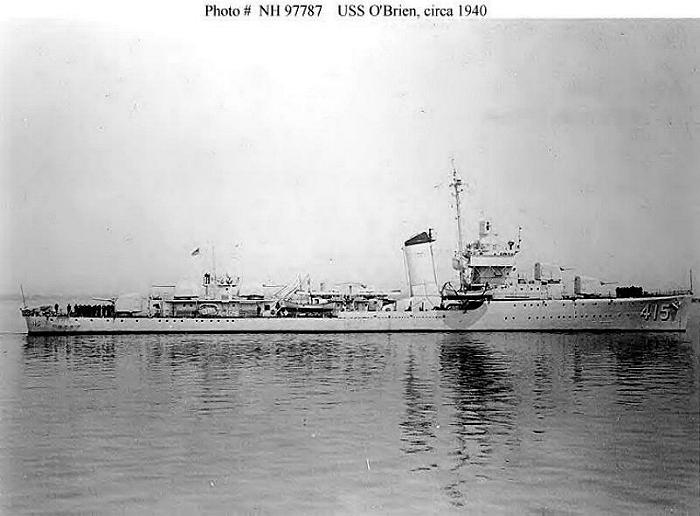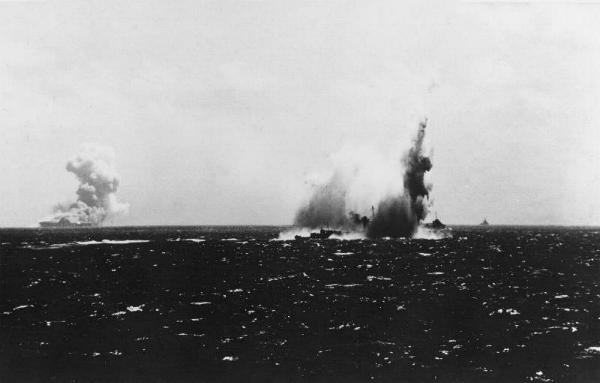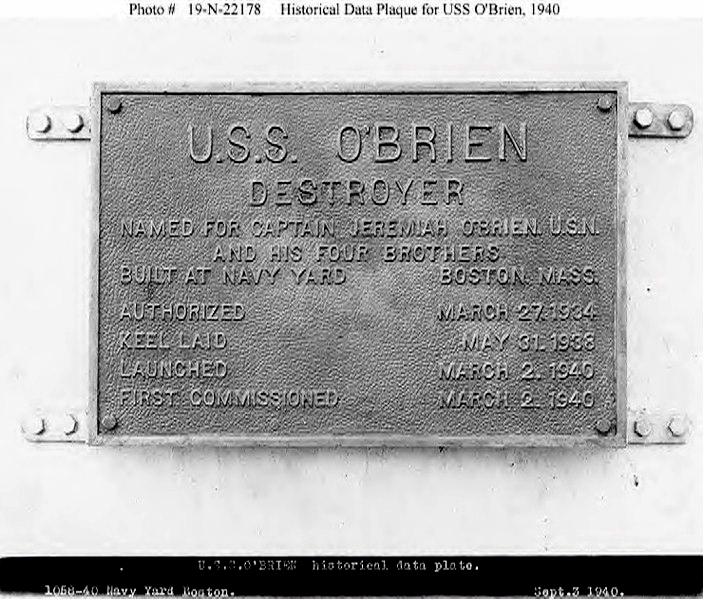

|
|
September 1942
USS O'Brien (DD-415) first found in USS Helena CL-50 War Diary on 3 September 1942,
USS O'Brien (DD-415) was a World War II-era Sims-class destroyer in the service
History
Name: USS O'Brien
General characteristics
Class and type: Sims-class destroyer World War II
After drydocking and repairs during the fall of 1941, O'Brien left Norfolk, Virginia
O'Brien steamed with a convoy for the Western Pacific on 4 February 1942, but she
After operating out of Pearl Harbor and patrolling the Hawaiian atoll, French Frigate Shoals,
O'Brien was retained at Pago Pago for local escort work. On 26 May, she supported the
Sinking.
While escorting a convoy of troop transports en route to Guadalcanal, the combined Task
At 1452, O'Brien sighted smoke coming from Wasp. As a member of the aircraft
This explosion did little obvious damage, but it set up severe structural stresses throughout
O'Brien made it to Suva in the New Hebrides on 13 October, and then steamed out once
of the United States Navy, named in honor of Captain Jeremiah O'Brien and his five
brothers, Gideon, John, William, Dennis and Joseph, who captured HMS Margaretta on
12 June 1775 during the American revolution. O'Brien was laid down at Boston Navy Yard,
Boston, Massachusetts, on 31 May 1938; launched on 20 October 1939; sponsored by
Miss Josephine O'Brien Campbell, a great-great-great granddaughter of Gideon O'Brien;
and commissioned on 2 March 1940, with Lieutenant Commander Carl F. Espe in command.
Since this warship was built in a drydock, along with the destroyers Walke, Lansdale,
and Madison, the christening and commissioning ceremonies were combined.
Builder: Boston Navy Yard
Laid down: 31 May 1938
Launched: 20 February 1939
Commissioned: 2 March 1940
Honors and American Defense Service Medal
awards: ("Fleet" clasp)
Asiatic-Pacific Campaign Medal (1 star)
World War II Victory Medal
Fate: Suffered structural damage as a result
of being torpedoed by I-19
15 September 1942, foundered on
19 October 1942 (all hands saved)
Displacement:
1,570 long tons (1,600 t) (std)
2,211 long tons (2,246 t) (full)
Length: 348 ft, 3¼ in, (106.15 m
)
Beam: 36 ft, 1 in (11 m)
Draft: 13 ft, 4.5 in (4.07 m)
Propulsion: High-pressure super-heated boilers,
geared turbines with twin screws,
50,000 horsepower
Speed: 35 knots
Range: 3,660 nautical miles at 20 kt
(6,780 km at 37 km/h)
Complement: 192 (10 officers/182 enlisted)
Armament: 5 × 5 inch/38, in single mounts
4 × .50 caliber/90, in single mounts
8 × 21 inch torpedo tubes in two quadruple mounts
2 × depth charge track, 10 depth charges
on 15 January 1942 along with the battleshipIdaho and the destroyer Mustin, and
then steamed for the Pacific Ocean. Transiting the Panama Canal on 20 January, the trio
of ships arrived in San Francisco, California, on 31 January.
was forced to return when a collision with the destroyer Case damaged her port side.
Following repairs at the Mare Island Navy Yard, the destroyer steamed out again on 20
February, bound for Pearl Harbor. There Commander Destroyer Division 4 shifted his flag
to O'Brien on 5 March 1942.
O'Brien called at Midway Island in the latter part of March, escorting the seaplane tender
Curtiss there to evacuate civilians. The two warships returned to Pearl Harbor on 3 April.
After an increase and improvement of her antiaircraft batteries, she embarked passengers for
transportation to the Naval Air Station at Palmyra Atoll, and then steamed out on 18 April
with the destroyers Flusser and Mugford. The destroyer then joined convoys from San Diego
and San Francisco to escort them to American Samoa, arriving at Pago Pago on 28 April.
occupation of Wallis Island, previously taken over by the Free French, and then she joined the
auxiliary vessel Procyon on 19 June for the return voyage to Pearl Harbor. Operating out of
Pearl Harbor, the ship performed escort duty and acted as patrol and plane guard. She got
underway on 17 August with Task Force 17 (TF 17) to reinforce the South Pacific Force,
screening the tanker Guadalupe.
Forces 17 and 18 were attacked by the Japanese submarine I-19 on 15 September 1942.
The aircraft carrier Wasp was sunk, and the battleship North Carolina and O'Brien
were damaged by a spread of six torpedoes from the submarine.
carrier Hornet'sASW screen, she made an emergency turn to the right. At about 1454,
while accelerating and swinging right, her lookouts spotted a torpedo two points forward of
the port beam, 1,000 yards (910 m) away. This torpedo then missed O'Brien close astern,
but while her crew's attention was concentrated on it, another torpedo hit her port bow.

Torpedo from I-19 hits O'Brien.
USS Wasp can be seen burning in the background.
the framework of O'Brien. She was able to proceed under her own power, and on
16 September she reached Espiritu Santo, where the sailors from Curtiss made temporary
repairs. O'Brien next steamed out on 21 September, bound for Noumea, New Caledonia,
for further repairs by the repair ship Argonne. Then, she steamed out on 10 October, bound
for San Francisco Bay.
more on 16 October.The rate of leakage of seawater into O'Brien continued to increase,
and on 18 October it was necessary for O'Brien to head for the nearest anchorage. Large
amounts of topside weights were jettisoned, and preparations were made for abandoning the
ship, but her captain still thought that she could be taken intact to Pago Pago. However, at
about 0600 on 19 October, her bottom suddenly split open considerably, and her forward and
after hull portions began to work independently. At 0630, all hands except for a small salvage
crew abandoned, but half an hour later O'Brien was abandoned entirely. Just before 0800
she descended beneath the waves, and after steaming nearly 3,000 nautical miles (5,600 km)
since she had been torpedoed. All members of her crew were saved.